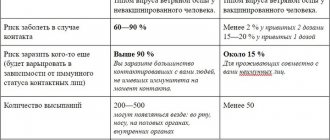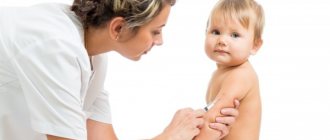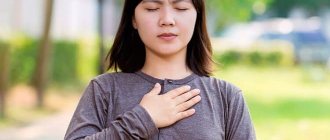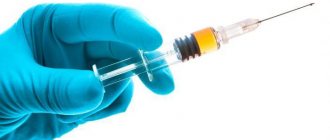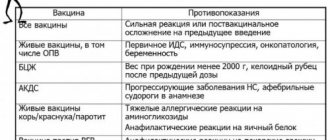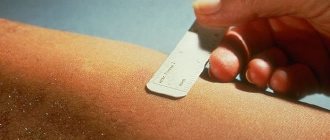Vaccination is an effective preventive measure that allows people to protect themselves from various types of infections and avoid serious diseases, including influenza. However, vaccination does not pass without a trace: it can cause some side effects. Knowing what not to do after getting a flu shot will help a person minimize the damage to their own health.
- First instructions
- The impact of vaccination on well-being
- List of prohibitions
- Alcohol
- Nutrition
- Communication with the outside world
- Bathing
- Medicines
- When the temperature rises
- Conclusion
First instructions
It is not recommended to leave the hospital or health center immediately after vaccination. Each individual body responds to the vaccine in its own way, and the first 20-30 minutes are allocated for adaptation. It is better to wait this time in the hospital (or on its territory) so that in the event of an unexpected reaction, the medical staff can provide assistance to the patient.
Please note : if a person previously tolerated vaccination easily, without complications, then adaptation is not necessary. However, children and people with chronic diseases need it.
The impact of vaccination on well-being
When a weakened or killed virus enters the human body, it causes a response. Sometimes it can be immediate, but more often it appears only after a few hours.
Please note : statistics have recorded that in Russia, after vaccination, 1% of people experience general side effects, and 4% experience local side effects.
The main manifestations of the reaction to the influenza virus:
- increase in body temperature to 37.5⁰С;
- chills, feeling of coldness in the hands and feet;
- general weakness;
- fast fatiguability;
- poor appetite;
- sweating;
- poor sleep or insomnia.
At the injection site you may experience:
- redness;
- itching, rash (signs of possible allergies);
- inflammation;
- slight swelling;
- compaction;
- painful sensations.
These symptoms are confirmation that a person has developed immunity to the flu. As a rule, the response to the vaccine lasts no more than a day and occurs without serious complications.
Please note : the children's body is more susceptible to the action of irritants, and therefore the listed symptoms appear more often (and more clearly) in children.
Vaccine options
The first influenza vaccines were made from killed or neutralized viruses, they are called whole virion vaccines, as well as from attenuated strains, the so-called live vaccines.
Almost all modern vaccinations for the prevention of influenza are inactivated (killed) vaccines with a replaceable strain composition. Influenza viruses for all vaccinations without exception are grown on chicken embryos, which is reflected in the list of contraindications for vaccination. Most inactivated whole-virion influenza shots consist of purified and concentrated viruses cultured in chicken embryos that have been inactivated by formaldehyde or UV irradiation. Inactivated vaccines, in turn, are divided into whole-virion vaccines, which are based on undestructed whole influenza viruses; pre-killed and purified, split, or split vaccines, which include particles of destroyed virions, that is, the full antigenic composition (external and internal proteins). Subunit influenza vaccines are also used, which consist of a mixture of two viral proteins: hemagglutinin and neuraminidase. Therefore, these vaccines have a minimal number of adverse reactions.
Virosomal vaccines are a new technology in the production of vaccination material. These vaccinations contain an inactivated virosomal complex with surface antigens of the influenza virus. Virosomes enhance the immune response to vaccination. The virosomal vaccine does not contain preservatives (thiomersal) and is well tolerated.
In Russia, the following inactivated trivalent influenza vaccinations are mainly used: “Grippovac”, “Vaxigrip”, “Begrivac”, “Agrippal S1”, “Grippol”, “Grippol plus”, “Influvac”, “Fluarix”, “Inflexal V” ( virsomal vaccine). A total of 18 vaccinations have been registered in Russia.
Classification of trivalent influenza vaccines
| Generation and type | Compound | Main characteristics | Examples |
Live vaccines | |||
| Whole virion vaccines | Live attenuated unpurified virus |
|
|
Inactivated vaccines | |||
| I – whole virion vaccines | Whole virus that has undergone inactivation and minor purification |
|
|
| II – split (split) vaccines | Particles of destroyed virus, surface and internal proteins and lipids |
|
|
| III – subunit vaccines | Highly purified influenza virus surface antigens (hemagglutinin and neuraminidase) |
|
|
| IV – subunit adjuvanted vaccines | Highly purified surface antigens of the influenza virus and an effective safe immunoadjuvant Polyoxidonium |
|
|
| Highly purified influenza virus surface antigens embedded in liposomes |
|
| |
| Highly purified surface antigens of influenza virus and adjuvant Sovidon |
|
| |
Classification of quadrivalent influenza vaccines
| Generation and type | Compound | Main characteristics | Examples |
| II – split (split) vaccines | Particles of destroyed virus, surface and internal proteins and lipids |
|
|
Reactogenicity is the ability of a vaccine to cause any side effects when introduced into the body (fever, local swelling, etc.)
List of prohibitions
Vaccination forces a person to change their lifestyle for several days and abstain from many usual things.
It is not recommended for anyone who has been vaccinated against the flu:
Visit a bathhouse or sauna, dive into an ice hole.
Sudden temperature changes, hypothermia and overheating are perceived by the body as a strong stress factor. Therefore, any water procedures other than standard swimming are strictly prohibited. Trips to water aerobics or the swimming section will also have to be postponed for a couple of days.
Swim in open waters.
Water in a river, pond or lake contains many pathogens that can enter through a fresh wound - the injection site. The development of inflammatory processes is ensured in 70% of cases.
Be in a crowd.
Large crowds of people are dangerous for the vaccinated person because each individual person is a potential source of the disease. In the post-vaccination period, the immune system tries to overcome the virus introduced with the vaccine, and therefore loses the ability to fight other pathogens. At this time, encountering disease carriers can negatively affect the patient's health.
Host/attend parties.
In addition to the large number of people at parties, there is another danger - the temptation to drink. As practice shows, not everyone manages to overcome this desire.
Try exotic dishes and get acquainted with new cuisine.
It is unknown how the digestive system will react to new unusual dishes - intoxication, allergies. Therefore, during a period of vulnerability, it is better to refrain from culinary experiments.
Play sports and be active physically.
A strong load on the body quickly exhausts you. Fatigue is followed by a deterioration in well-being, even short-term fainting is possible. Sports competitions, training, general cleaning, washing (by hand) - all these events must be postponed. It is better for a person to remain calm for 2-4 days.
Leave the city.
Flu symptoms can appear suddenly without help available. The effects of vaccination are most easily tolerated in a quiet, calm home environment. In the city it is possible to visit a doctor in case of unexpected complications. Therefore, it is better to stay at home for a couple of days after vaccination.
Compliance with all of the above recommendations will minimize the risk of getting sick.
Also, within 10 days after vaccination, a person is prohibited from donating blood as a donor. The virus introduced with the vaccine remains in the patient’s blood. People who need blood transfusions are physically weak. The entry of the virus into their vulnerable body will provoke the development of the disease and can lead to death.
Blood tests taken during the post-vaccination period will show a false result.
Alcohol

Adults who have been vaccinated against influenza are wondering whether they can drink alcohol after vaccination. Doctors respond with a strict ban, and there are several logical explanations for this:
- During the post-vaccination period, a person should remain in a calm state. Physical or nervous overexcitation caused by alcohol is contraindicated - this factor reduces the effectiveness of the vaccine by almost half.
- One of the side effects of the flu shot is weakness. Alcohol will only worsen a person’s physical condition: increased dizziness, a feeling of “breaking” bones, and muscle pain.
- Drinking alcohol increases the risk of developing the disease. Alcohol weakens the immune system, so the body will not be able to fight the virus received with the vaccine. Influenza infection will occur.
Thus, alcohol increases the patient’s painful condition, and also negates all prevention.
Immunologists advise refraining from drinking alcohol for three days after vaccination. After vaccination, you should not drink “weak” alcoholic drinks, energy drinks, non-alcoholic beer and kvass - they also reduce the effectiveness of vaccination.
Nutrition
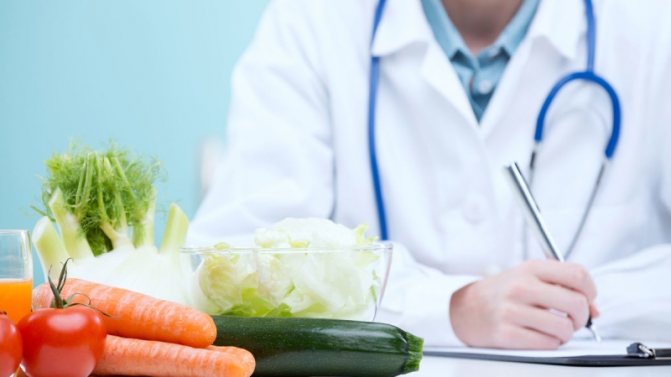
Vaccination often entails dysfunction of the gastrointestinal tract, and therefore it is better not to overload it for 3-4 days.
After the vaccine is administered, it is recommended to abstain from eating for an hour. For the next couple of days, you should exclude fatty, heavy foods, empty carbohydrates (sweets, chips), soda, and coffee from your diet.
Meat takes a long time to digest and creates a feeling of congestion in the stomach, so it is better to give preference to vegetables and fruits, cereals, and broth. Fried foods can be replaced with steamed ones.
Abuse of unhealthy foods and overeating are common causes of nausea, stomach pain, and upset.
During the rehabilitation period you need to drink a lot of water.
Communication with the outside world

As already mentioned, active rest after vaccination can lead to unpleasant consequences.
In the next 2-3 days, doctors recommend going for walks in a green area (park, square). This environment is good for health, while minimizing contact with other people.
After vaccination, it doesn’t hurt to take a day off to allow your body to recover. Vaccination suppresses both physical and brain activity, so a person’s performance these days also decreases.
Which vaccine is more effective against influenza?
The therapeutic effect of Grippol plus and Sovigrippa is no different.
According to the opinion of many doctors, most are inclined to choose Sovigrippa. This is due to the wide range of therapeutic effects and few side effects.
Laboratory studies confirm the full compliance of vaccines with medical requirements.
The therapeutic duration of the products does not differ. Antiviral activity is noted 2-3 days after vaccination. The protective properties of pharmaceuticals last up to 6-12 months.
Bathing

Some doctors allow patients to shower on the day of vaccination, as long as they do not rub the injection site with a washcloth. However, when it comes to a small child, it is better to avoid getting water on his wound. The baby can be dried with a towel dipped in warm water. In one evening the wound will heal, and the next day swimming will not pose any danger.
As it was before
The lack of foreign vaccines during the epidemiological season is an annual problem. In 2021, according to Vedomosti, Vaxigripp produced by Sanofi Pasteur was delivered only by the end of September, while Influvac was not delivered at all. In 2021, according to Rossiyskaya Gazeta, at the beginning of October it was impossible to be vaccinated with a foreign vaccine in Russia.

Sanofi told RBC that in 2021 they plan to continue supplying the vaccine to prevent influenza. “The vaccine will arrive in the country to further undergo the procedure for introducing it into civilian circulation and no earlier than in October, it will be available for shipment from the warehouse of Sanofi Russia JSC. The vaccine will be available through the traditional distribution network,” Yuri Mochalin, director of corporate relations at Sanofi in the Eurasian region, explained to RBC.
Abbott did not respond to RBC’s request about whether it plans to supply the Influvac vaccine to Russia.
Medicines
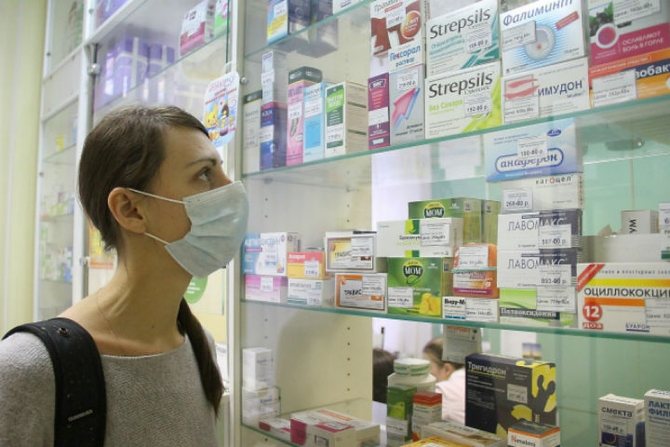
Taking some medications after getting a flu shot can be harmful to a person's health.
Ideally, only healthy people should be vaccinated. Colds, malaise, fever and exacerbation of chronic diseases are contraindications to vaccination. However, there are situations when taking medications is necessary.
This applies to antihistamines. After vaccination, children and adults are not recommended to drink Suprastin and Tavegil. These drugs deactivate the production of mucus in the respiratory tract. As a result, the protective function of the bronchi is disrupted, and the main factor that prevents the penetration of allergens and pathogens inside disappears. Under such conditions, the risk of getting sick increases several times.
Therefore, it is better to replace Suprastin with Zyrtec and Fenistil.
It is also necessary to avoid taking vitamin D in the next 5 days after vaccination. This is due to the fact that vitamin D provokes calcium imbalance and greater sensitivity to allergens.
Sovgripp ® inactivated subunit influenza vaccine
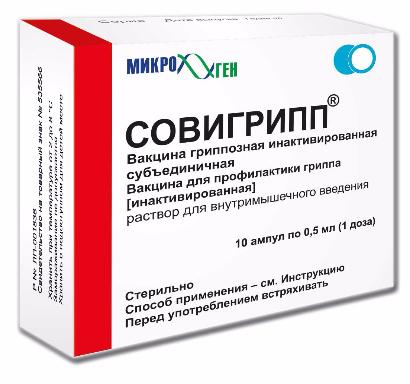
Trade name.
SOVIGRIP®
Group name.
Influenza vaccine [inactivated].
Dosage form.
Solution for intramuscular administration.
The vaccine is a surface glycoprotein (hemagglutinin and neuraminidase), isolated from purified influenza virus virions of types A and B, obtained from virus-containing allantoic fluid of chicken embryos from clinically healthy chickens using chicken erythrocytes or erythrocyte-free technology in the production process, and diluted in phosphate-saline buffer solution, in combination with the adjuvant SOVIDON. The flu shot is available with a preservative - thiomersal (merthiolate), or without a preservative.
The antigenic composition of strains changes annually in accordance with WHO recommendations.
Compound.
1 dose (0.5 ml) contains:
Vaccine with preservative
- hemagglutinin of influenza virus subtype A(H1N1) - 5 μg;
- hemagglutinin of influenza virus subtype A (H3N2) - 5 μg;
- hemagglutinin of influenza virus type B - 11 mcg;
- adjuvant SOVIDONTM - 500 mcg;
- preservative - thiomersal (merthiolate) - (50.0 ± 7.5) mcg;
- phosphate-buffered saline solution - up to 0.5 ml.
Vaccine without preservative
- hemagglutinin of influenza virus subtype A(H1N1) - 5 μg;
- hemagglutinin of influenza virus subtype A(H3N2) - 5 μg;
- hemagglutinin of influenza virus type B - 11 mcg;
- adjuvant SOVIDONTM - 500 mcg;
- phosphate-buffered saline solution - up to 0.5 ml.
Note. Composition of phosphate-buffered saline solution No. 1 (for the drug without a preservative):
9 g of sodium chloride, 1.5 g of sodium hydrogen phosphate, 0.12 - 0.14 g of potassium dihydrogen phosphate, water for injection up to 1 liter.
Composition of phosphate-buffered saline solution No. 2 (for a drug with a preservative):
9 g of sodium chloride, 1.5 g of sodium hydrogen phosphate, 0.12 - 0.14 g of potassium dihydrogen phosphate, 0.85 ml of thiomersal (merthiolate) solution 1%, water for injections up to 1 l.
Description.
Colorless or slightly yellowish transparent or slightly opalescent liquid.
Immunological properties.
The vaccine forms high specific immunity against seasonal influenza.
Pharmacotherapeutic group.
MIBP vaccine.
ATX code. J07ВВ02 Indications for the use of influenza vaccinations Sovigripp.
For active annual preventive immunization against seasonal influenza, a preservative-free vaccine is used in children from 6 months of age, adolescents and adults without any age limit, and in pregnant women in the 2nd-3rd trimester of pregnancy;
vaccine with a preservative - in adults over 18 years of age. The vaccine is especially indicated. 1. Persons at high risk of illness and complications in case of influenza:
- persons over 60 years of age;
children of preschool age. schoolchildren; - persons who often suffer from acute respiratory viral infections; - persons suffering from chronic somatic diseases, including diseases and malformations of the cardiovascular, respiratory and central nervous systems, chronic kidney diseases, metabolic diseases, diabetes mellitus, chronic anemia, allergic diseases (except for allergies to chicken proteins); congenital or acquired immunodeficiency, including infection with the human immunodeficiency virus; - pregnant women. 2. Persons who, due to the nature of their educational or professional activities, have a high risk of contracting the flu or infecting others with it:
- students;
— medical workers; — workers in the social sphere, management, education, services, public catering, transport, trade; - military personnel, police. Contraindications for use.
1. Allergic reactions to chicken protein or other components of the vaccine.
2. Severe post-vaccination reactions (temperature above 40 °C, the appearance of edema at the site of vaccine administration, hyperemia over 8 cm in diameter) or post-vaccination complications (collapse, non-febrile convulsions, anaphylaxis) to the previous administration of influenza vaccine. 3. Pregnancy (when using a vaccine with a preservative). 4. Age up to 18 years (when using a vaccine with a preservative). 5. Age up to 6 months. Temporary contraindications.
1. Acute febrile conditions, acute infectious and non-infectious diseases, including the period of convalescence.
Vaccination is usually carried out 2-4 weeks after recovery. 2. Chronic diseases in the acute stage. Vaccination is carried out during the period of remission. The possibility of vaccination of persons suffering from chronic diseases is determined by the attending physician, based on the patient’s condition. 3. For mild forms of acute respiratory viral and intestinal infections, vaccination is carried out after the temperature has normalized and/or the acute symptoms of the disease have disappeared. Method of administration and dose.
- Vaccination is carried out annually in the autumn-winter period.
- Vaccination is possible at the beginning of an epidemic rise in the incidence of influenza.
- For children over 3 years of age, adolescents and adults without age restrictions, the vaccine is administered once intramuscularly into the upper third of the outer surface of the shoulder (in the area of the deltoid muscle) in a vaccination dose of 0.5 ml.
- For children from 6 months to 3 years, the vaccine is administered twice with an interval of 4 weeks into the anterior outer surface of the thigh intramuscularly in a vaccination dose of 0.25 ml (1/2 dose) according to the following administration regimen:
1. From an ampoule containing 0.5 ml (1 dose) of the drug, 0.25 ml of the vaccine is taken with a sterile syringe that has the appropriate graduation. The remainder of the vaccine in the ampoule must be discarded immediately. 2. When using a syringe containing 0.5 ml of the drug, it is necessary to remove half of the contents by pressing the syringe plunger to the corresponding mark on the syringe. The remaining amount of vaccine (0.25 ml) is administered to the patient. The opening of ampoules and the vaccination procedure are carried out in strict compliance with the rules of asepsis and antiseptics. The drug cannot be stored in opened ampoules/syringes
.
is NOT SUITABLE
for use in ampoules with altered physical properties (color, transparency), damaged integrity and labeling, expired shelf life, violations of storage and/or transportation conditions.
Precautions for use.
- Do not administer intravenously!
- On the day of vaccination, those vaccinated must be examined by a therapist/paramedic with mandatory thermometry. At temperatures above 37 °C, vaccination is not carried out.
- Vaccination sites must be equipped with anti-shock therapy. The vaccinated person must be under medical supervision for 30 minutes after administration of the drug.
Symptoms of overdose, measures to assist in case of overdose.
Cases of overdose have not been established.
Side effect.
The vaccine is a highly purified drug and is well tolerated by those vaccinated.
The following reactions may develop: Very often (>1/10):
- local reactions: pain on palpation, induration, swelling and hyperemia of the skin at the injection site;
- systemic reactions: low-grade fever, malaise, headache, sore and sore throat, slight runny nose.
Often (1/10 -1/100):
- systemic reactions: dizziness, myalgia, arthralgia, abdominal pain, increased fatigue.
These local and systemic reactions are transient and disappear after 1-2 days without specific therapy. Very rare (< 1/10,000):
- with high individual sensitivity, allergic reactions may be observed: anaphylactic shock, angioedema, urticaria, rash (erythematous, papular), etc.
Interaction with other drugs.
The vaccine can be administered against the background of basic therapy for the underlying disease.
Vaccination in persons receiving immunosuppressive therapy may be less effective. The vaccine can be used simultaneously with other inactivated vaccines (with the exception of rabies). In this case, contraindications to each of the vaccines used must be taken into account; the drugs must be injected into different parts of the body with different syringes. Use during pregnancy and breastfeeding.
Data from clinical trials of the vaccine on pregnant women have shown that vaccination does not have a negative effect on the fetus, the body of the woman and the child and can be used during pregnancy.
Vaccination with this drug can be carried out starting from the second trimester of pregnancy. Experience with the use of inactivated influenza vaccines shows that vaccination of a woman during breastfeeding does not have a toxic effect on the child and can be used. The final decision to vaccinate pregnant and breastfeeding women should be made by a physician individually, taking into account the risk of contracting influenza and possible complications of influenza infection. Information about the possible effect of the drug on the ability to drive vehicles and machinery.
Not installed.
Release form.
Solution for intramuscular administration, 0.5 ml (1 dose) in ampoules or single-use syringes with a needle and protective cap.
10 ampoules each with instructions for use and an ampoule scarifier in a cardboard box (pack). 5 ampoules in a blister pack. 2 blister packs each with instructions for use and an ampoule scarifier in a cardboard pack. 10 ampoules in a blister pack. 1 blister pack with instructions for use and an ampoule scarifier in a cardboard box (pack). When packaging ampoules that have a break ring or a point for opening, an ampoule scarifier is not included. 1 syringe in a blister pack. 1 blister pack with instructions for use in a cardboard pack. 1 bottle with instructions for use in a cardboard pack. Expiration date.
1 year.
Do not use after the expiration date stated on the packaging. Transportation conditions.
Transport at temperatures from 2 to 8 °C.
Freezing is not allowed. Storage conditions.
Store at a temperature of 2 to 8 °C out of the reach of children.
Freezing is not allowed. Vacation conditions.
For medical institutions (vaccine in ampoules and disposable syringes). Available by prescription (vaccine in vials and disposable syringes). Registration certificate holder of JSC NPO Microgen Russia, 115088, Moscow, st. 1st Dubrovskaya, 15, building 2, tel. (495) 710-37-87, e-mail Organization receiving claims: JSC NPO Microgen Russia, 115088, Moscow, st. 1st Dubrovskaya, 15, building 2, tel. (495) 710-37-87, e-mail Manufacturer/production address: JSC NPO Microgen Russia, 450014, Republic of Bashkortostan, Ufa, st. Novorossiyskaya, 105, tel.; or FSUE SPbNIIVS FMBA of Russia Russia, 198320, St. Petersburg, Krasnoe Selo, st. Svobody, 52, tel., fax; or FORT LLC Russia, 390540, Ryazan region, Ryazan district, Okskoye s/p, 1z, tel..
Complaints regarding the quality of the drug, with the obligatory indication of the batch number and release date, as well as information about cases of increased reactogenicity or the development of post-vaccination complications, should be sent to the Federal Service for Surveillance in Healthcare (Roszdravnadzor) and to the organization receiving the claims, with subsequent submission medical documentation.
When the temperature rises
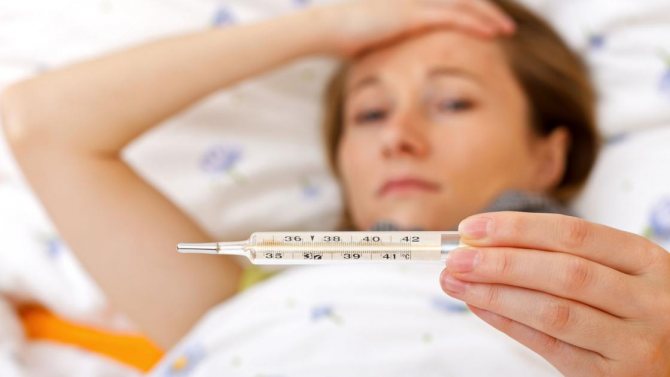
One of the common phenomena of the post-vaccination period is an increase in body temperature - this indicates activation of the immune system. Almost every vaccinated child faces this problem. What should parents do in this case? The instructions are:
If the thermometer readings do not reach 38⁰C.
There is no need to resort to the help of traditional or traditional medicine and bring down the temperature. In this case, antipyretics can harm the child’s body.
If the temperature is above 38⁰C.
It is necessary to give the child Paracetamol or Ibuprofen. Parents should remember that Aspirin irritates the gastrointestinal tract and creates a burden on the child’s fragile digestive system. Therefore, this antipyretic drug is contraindicated after vaccination.
Young, inexperienced parents make the mistake of wrapping their child in warm clothes and a blanket when the temperature rises. This should not be done, as the baby is at risk of overheating.
It is better to leave light clothing on the child or completely undress him and cover him with a thin sheet.
Please note : if the temperature persists for 2-3 days, this is a good reason to call a doctor.
Vaccination rules
The drugs Sovigripp and Grippol plus are used at the same time. Traditionally, vaccination is carried out in the off-season, when the risks of epidemic activity increase.
The drug is used for parenteral administration. The main injection sites are the muscles of the thigh, shoulder and, less commonly, the buttock.
The dosage depends on age:
- From 6 months to 3 years - 0.25 ml twice with a break of 4 weeks, if vaccination is carried out for the first time. Previously vaccinated children receive a single injection with a dosage of 0.5 ml.
- Children over 3 years old and adults - 0.5 ml 1 time.
- Persons with immunodeficiency - 0.5 ml 2 times with an interval of 4 weeks.
